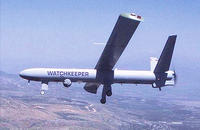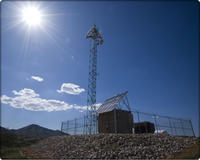-
DHS and CBP make a pitch to border security vendors
Boeing’s failure to provide a reliable border security solution has opened up opportunities for border protection technology vendors. These opportunities are offered by DHS’s proposed Integrated Fixed Towers (IFT) acquisition program which aims to replace SBInet
-
-
Air Force to deploy supercomputer aboard a superblimp
The U.S. Air Force is developing a massive blimp to gather and process all intelligence feeds from Afghanistan; the air ship will be longer than a football field and seven times the size of the Goodyear Blimp and will be able to stay afloat for nearly a week at nearly four miles up; the key feature of the ship will be its sophisticated supercomputer which can process 300 terabytes of data an hour; this computer will help limit data overload as surveillance sensors become increasingly complex; it currently takes fourteen analysts to monitor a single feed from a predator and the next generation drones will have ninety-six cameras; the blimp’s first test flight is scheduled for 15 October
-
-
Cobham acquires Baltimore surveillance specialists
U.K.-based Cobham acquires Baltimore-based Corp Ten International; Corp Ten develops software to manage multiple tracking and surveillance devices in a single system, which allows real-time sharing of data and other communications between users through satellite, cellular, and radio frequency providers
-
-
University offers unmanned drone program to students
Indiana State University (ISU) has announced that it is offering an “unmanned systems” program to its students; the program is one of the few in the nation that trains students in the use of unmanned aerial vehicles (UAVS); ISU hopes to expand the program to include local and state agencies; ISU is already working with the local police department to conduct search and rescue exercises; other uses include civilian agricultural mapping
-
-
More than half of iPhone apps track users
A recent study found that more than half of all iPhone apps could track users and collect data without an individual’s knowledge; researchers analyzed more than 1,400 iPhone apps to determine how they handle sensitive data; more than half collect an individual’s unique device ID or track a user’s location, and when combined with links to a Facebook account the app could gain a lot of sensitive data; researchers found that thirty six apps blatantly violated privacy rights by accessing an individual’s location without informing the user, while another five went so far as to take data from the user’s address book without first seeking permission
-
-
Free program to detect suspicious vehicles unveiled
Funded by the Federal Emergency Management Agency (FEMA) and administered by the TSA, the First Observer program encourages parking lot operators to watch for oddities such as improperly parked cars, civilians conducting surveillance, and strange odors such as diesel from gasoline vehicles
-
-
Technology tracks produce from growth to delivery

The new federal food safety bill has sparked a technology race among companies to provide simple electronic tracking systems for individual items of produce; the new law mandates that each part of the supply chain keep electronic records of where they received items from and where they shipped it to; this comes as a result of a large salmonella outbreak in 2008 that reached more than forty states and infected more than 1,300 people; poor records led to misidentification and slow recalls in that outbreak; every year 3,000 people die from food-borne illnesses while one in six people suffer from food poisoning
-
-
Detecting criminals coming back to the scene of the crime
Criminals tempted to return to the scene of the crime may want to resist this impulse; Notre Dame University researchers are developing a tool which will reliably identify criminals who may be hanging out at the crime scene after the event; the Questionable Observer Detector (QuOD) can process any available video clips of groups of people present at the scene of event, spanning different times and locations to pick out any person who appears frequently in them
-
-
Dramatic expansion of DC surveillance camera network
Washington, D.C. is proposing a plan that would add thousands of surveillance camera feeds from local businesses to the city’s homeland security agency existing command center; the city already monitors more than 4,500 cameras placed in its public transportation system and schools; critics say that this is a poor use of resources and violates civil liberties; cities like New York, London, and Baltimore already employ this practice
-
-
Domestic use of drones make privacy advocates anxious
The age of Micro Air Vehicle (MAV) UAV is coming; for now, use of these types of drones for high-risk law enforcement purposes is rare, although the Federal Aviation Administration (FAA) plans to implement new rules that would allow the routine flying of these drones across the United States by 2013; equipped with high-resolution, infrared and thermal-imaging cameras, these drones could provide police with the accurate monitoring of all types of civilian areas and topographies; privacy advocates worry
-
-
Ogden, Utah buys its police a blimp
The mayor of Ogden, Utah, wants to buy a blimp to help the city police fight crime; Mayor Matthew Godfrey says a blimp is “far less expensive to purchase and to operate than the other UAVs that are out there”; Godfrey envisions using a blimp “largely to patrol,” and said that another benefit of the model being developed for Ogden is that its route can be pre-programmed; he also highlights the blimp’s “deterrent factor”
-
-
Amnesty complains about Brits training on Israeli UAVs

The British Army has ordered at least thirty Israeli-origin UAVs under the Watchkeeper program; the platform, called WK-450, has been based on the Hermes-450 UAV, produced by Israel’s Elbit Systems; in an interim measure, the British Army has ordered the Hermes-450 for its contingent in the NATO stabilization mission in Afghanistan; Amnesty International complains that British Army personnel have been training in Israel on these UAVs — UAVs which are deployed in the Gaza Strip where, according to Amnesty, the drones were involved “in serious human rights violations”
-
-
Police want UAVs for domestic surveillance
Police agencies around the United States soon could be using UAVs for law enforcement missions such as finding lost children, hunting illegal marijuana crops, and easing traffic jams in evacuations of cities before hurricanes or other natural disasters; local governments have been pressing the Federal Aviation Administration (FAA) for wider use of UAVs — a demand driven largely by returning veterans who observed the crafts’ effectiveness in war
-
-
Camera better than the human eye
Researchers developed a curvilinear camera, much like the human eye, with the significant feature of a zoom capability, unlike the human eye; the “eyeball camera” has a 3.5x optical zoom, takes sharp images, is inexpensive to make and is only the size of a nickel; the camera will not be appearing at Best Buy any time soon, but the tunable camera — once optimized — should be useful in many applications, including night-vision surveillance, robotic vision, endoscopic imaging, and consumer electronics
-
-
DHS pulls plug on virtual border fence project

DHS has cancelled the ambitious SBInet border security project; the project aimed to erect a virtual fence along the U.S.-Mexico border, consisting of a system of cameras and sensors which would allow officers to monitor crossings and dispatch Border Patrol agents to catch anyone entering the United States illegally; Boeing, the primary contractor, was hobbled by technical problems involving the effectiveness of video cameras and other elements, resulting in the project falling far off schedule; a year ago, after DHS had spent $672 million on the project and Boeing had little to show for the money, the project was put on hold; DHS will now look at an alternative system which is likely to rely more on UAVs and thermal imaging
-
- All
- Regional
- Water
- Biometrics
- Borders/Immig
- Business
- Cybersecurity
- Detection
- Disasters
- Government
- Infrastructure
- International
- Public health
- Public Safety
- Communication interoperabillity
- Emergency services
- Emergency medical services
- Fire
- First response
- IEDs
- Law Enforcement
- Law Enforcement Technology
- Military technology
- Nonlethal weapons
- Nuclear weapons
- Personal protection equipment
- Police
- Notification /alert systems
- Situational awareness
- Weapons systems
- Sci-Tech
- Sector Reports
- Surveillance
- Transportation
Advertising & Marketing: advertise@newswirepubs.com
Editorial: editor@newswirepubs.com
General: info@newswirepubs.com
2010-2011 © News Wire Publications, LLC News Wire Publications, LLC
220 Old Country Road | Suite 200 | Mineola | New York | 11501
Permissions and Policies
Editorial: editor@newswirepubs.com
General: info@newswirepubs.com
2010-2011 © News Wire Publications, LLC News Wire Publications, LLC
220 Old Country Road | Suite 200 | Mineola | New York | 11501
Permissions and Policies
